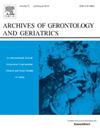老年人握力-步速与轻度认知障碍和特定认知能力的双向关联:一项纵向分析。
IF 3.5
3区 医学
Q2 GERIATRICS & GERONTOLOGY
引用次数: 0
摘要
背景:以往的研究表明,身体表现与轻度认知障碍(MCI)有关。握力和步态速度作为易于测量的衰老生物标志物,可以有效地反映身体功能。然而,握力、步态速度以及两者的结合是否与MCI和特定认知功能域双向相关,尚未得到探讨。方法:采用广义估计方程(generalized estimation equation, GEE)检验握力与MCI、步速与MCI之间的双向关系,以及握力与步速、MCI之间的组合关系。采用GEE进一步估计握力结合步态速度与5个认知功能域之间的双向关系。结果:共纳入2227名老年人(3波)。低握力组MCI风险较高(OR = 1.78;P < 0.001),与正常握力组相比,低步速组更高(OR = 1.71;P < 0.001)。低握力合并低步态速度与MCI的相关性最大(OR = 4.13;P < 0.001),定向、即时记忆、延迟记忆、注意力和计算能力以及语言能力下降。患有轻度认知障碍的老年人在这五个认知领域的衰退也与握力和步态速度下降有纵向关系。结论:主要研究结果揭示了定期监测老年人握力、步态速度、整体认知和特定认知功能域的重要性。早期干预握力、步态速度和认知功能可能实现互惠互利。本文章由计算机程序翻译,如有差异,请以英文原文为准。
Bidirectional associations of grip strength-gait speed with mild cognitive impairment and specific cognitive abilities among older adults: A longitudinal analysis
Background
Previous studies showed that physical performance was associated with mild cognitive impairment (MCI). As the easily measured aging biomarkers, grip strength and gait speed could effectively reflect physical function. However, whether grip strength, gait speed, and the combination of the two were bidirectionally associated with MCI and specific cognitive function domains, have not been explored.
Methods
The bidirectional relationships between grip strength and MCI, gait speed and MCI, and the combination of grip strength with gait speed and MCI, were examined by generalized estimating equation (GEE). GEE was performed to further estimate the bidirectional relationships between grip strength combined with gait speed and the five domains of cognitive function, respectively.
Results
In total, 2,227 older adults (3 waves) were included. The MCI risk was higher for low grip strength group (OR = 1.78; P < 0.001) compared to normal grip strength group, as well as higher for low gait speed group (OR = 1.71; P < 0.001) compared to normal gait speed group. Low grip strength combined with low gait speed had the maximum associations with MCI (OR = 4.13; P < 0.001) and decline in orientation, immediate memory, delayed memory, attention and calculation, and language. Older adults with MCI and decline in those five domains of cognition also longitudinally related to lower grip strength and lower gait speed.
Conclusion
The main findings revealed the importance of regularly monitoring grip strength, gait speed, global cognition, and specific cognitive function domains among older people. Early interventions for grip strength, gait speed, and cognition function might achieve reciprocal benefits.
求助全文
通过发布文献求助,成功后即可免费获取论文全文。
去求助
来源期刊
CiteScore
7.30
自引率
5.00%
发文量
198
审稿时长
16 days
期刊介绍:
Archives of Gerontology and Geriatrics provides a medium for the publication of papers from the fields of experimental gerontology and clinical and social geriatrics. The principal aim of the journal is to facilitate the exchange of information between specialists in these three fields of gerontological research. Experimental papers dealing with the basic mechanisms of aging at molecular, cellular, tissue or organ levels will be published.
Clinical papers will be accepted if they provide sufficiently new information or are of fundamental importance for the knowledge of human aging. Purely descriptive clinical papers will be accepted only if the results permit further interpretation. Papers dealing with anti-aging pharmacological preparations in humans are welcome. Papers on the social aspects of geriatrics will be accepted if they are of general interest regarding the epidemiology of aging and the efficiency and working methods of the social organizations for the health care of the elderly.

 求助内容:
求助内容: 应助结果提醒方式:
应助结果提醒方式:


